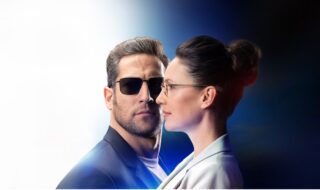
Summer and Blue Light
Summer is synonymous with fun in the sun. Unfortunately, most consumers may not know about resulting damage to the eyes. And, even if they have been trained to wear high-quality sunnies in the summer, they may still be ignoring the dangers of exposure to blue light indoors. To help you communicate the potential damage both blue light and UV exposure can cause, here are a few stats that may get them to pay more attention to protecting their peepers. Plus, we give you a first look at the new Shamir Blue Zero™ clear lens material with built-in protection from blue light and UVA/UVB.
Tip: Check out the new Shamir Blue Zero™ blue-blocking lens.
DANGER TO ALL AGES
We always hear about the cumulative effects of exposure (see below) and why it’s so important to protect the eyes of children. Folks at the other end of the age spectrum are in plenty of danger, too. “Blue rays…seem to accelerate age-related macular degeneration more than other rays in the spectrum. That’s partly because, as people age, they lose melanin, the body’s ‘sunscreen.’ In fact, more than half the body’s melanin is gone by age 65.” Source: The American Macular Degeneration Foundation
PROBLEMS OUTDOORS
- ELEVATION: Patients should be afraid of heights, when it comes to UV anyway. Why? Because the intensity of UV radiation increases 3% for every 1,312 feet in altitude. Put another way, at 8,000 feet, UV radiation exposure is almost 20% more than at sea level. That’s because at higher elevations, the air is thinner, allowing for more UV radiation in the atmosphere. Source: American Optometric Association and VSP
- ACHOO: Antihistamines are often recommended for summer allergies. Unfortunately, they are photosensitizing drugs (they increase sensitivity to the sun) that absorb light energy and undergo a photochemical reaction resulting in chemical modification of tissue. Besides causing short-term visual damage, they can raise susceptibility to cataracts and macular degeneration. Source: WebMD
PROBLEMS INDOORS
- YOUNG EYES: The impact of all this exposure is particularly critical for young children because the crystalline lens and cornea are still forming. That’s definitely a problem considering that children spend more than seven hours a day in front of digital media/devices. Source: The Kaiser Family Foundation
- FLICKER: Blue light wavelengths aren’t just short. They’re also high energy. HEV wavelengths flicker more than other wavelengths, and that means increased glare and potential reduction in visual contrast and clarity. Source: bluelightexposed.com
NEW SOLUTION…BLUE ZERO
A new solution just came to market June 1. It’s the Shamir Blue Zero™ blue-blocking clear lens. According to the company, it was created in response to the growing demand for protection from potentially harmful artificial light within the 415-455nm range. It also absorbs harmful UVA and UVB rays.
Since a picture really is worth a thousand words, check out the video at the link below. And share it with your patients, too. https://youtu.be/4M2coXDsnLQ
How do you talk to patients about blue light and UV radiation? Do you discuss products like Shamir Blue Zero in the chair? Tell us and share in the Facebook conversation here.
Comments are closed.









